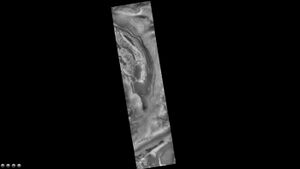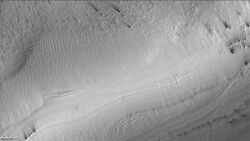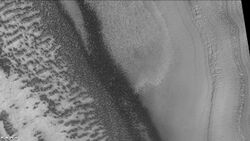Reynolds (crater)
Topic: Astronomy
 From HandWiki - Reading time: 5 min
From HandWiki - Reading time: 5 min
 Reynolds (crater), as seen by CTX camera (on Mars Reconnaissance Orbiter). | |
| Planet | Mars |
|---|---|
| Region | Mare Australe quadrangle |
| Coordinates | [ ⚑ ] : 75°06′S 157°54′W / 75.1°S 157.9°W |
| Diameter | 91 km |
Reynolds is an impact crater on Mars, located in the Mare Australe quadrangle at 75.1°S latitude and 157.9°W longitude and is in the southernmost portion of Terra Sirenum. It measures 91 kilometers in diameter and was named after British physicist Osborne Reynolds.[1]
Spiders


During the winter, much frost accumulates. It freezes out directly onto the surface of the permanent polar cap, which is made of water ice covered with layers of dust and sand. The deposit begins as a layer of dusty CO
2 frost. Over the winter, it recrystallizes and becomes denser. The dust and sand particles caught in the frost slowly sink. By the time temperatures rise in the spring, the frost layer has become a slab of semi-transparent ice about 3 feet thick, lying on a substrate of dark sand and dust. This dark material absorbs light and causes the ice to sublimate (turn directly into a gas) Eventually much gas accumulates and becomes pressurized. When it finds a weak spot, the gas escapes and blows out the dust. Speeds can reach 160 km (100 miles) per hour.[2] Dark channels can sometimes be seen; they are called "spiders."[3][4][5] The surface appears covered with dark spots when this process is occurring.[6][7] These features can be seen in some of the pictures below.
See also
References
- ↑ "Gazetteer of Planetary Nomenclature | Reynolds". International Astronomical Union. http://planetarynames.wr.usgs.gov/Feature/5010.
- ↑ "Gas jets spawn dark 'spiders' and spots on Mars icecap | Mars Odyssey Mission THEMIS". http://themis.asu.edu/news/gas-jets-spawn-dark-spiders-and-spots-mars-icecap.
- ↑ Benson, M. 2012. Planetfall: New Solar System Visions
- ↑ "Spiders Invade Mars". http://www.astrobio.net/topic/solar-system/mars/spiders-invade-mars/.
- ↑ Kieffer H, Christensen P, Titus T. 2006 Aug 17. CO
2 jets formed by sublimation beneath translucent slab ice in Mars' seasonal south polar ice cap. Nature: 442(7104):793-6. - ↑ "Gas jets spawn dark 'spiders' and spots on Mars icecap | Mars Odyssey Mission THEMIS". http://themis.asu.edu/news/gas-jets-spawn-dark-spiders-and-spots-mars-icecap.
- ↑ "Thawing 'Dry Ice' Drives Groovy Action on Mars". http://www.jpl.nasa.gov/news/news.php?release=2013-034.
Recommended reading
- Grotzinger, J. and R. Milliken (eds.). 2012. Sedimentary Geology of Mars. SEPM.
 |
 KSF
KSF